技术规格书汇总
(完整版)技术规格书汇总,推荐文档

(3)线制:四线制,与控制器采用无极性信号二总线连接,与电源线采用无极性二线
制连接
(4)声压级:80dB~115dB(前方 3m 水平处(A 计权)) (5)闪光频率:1.0Hz~1.4Hz
(6)变调周期:4s(1±20%)
(7)声调:火警声
(8)使用环境:
温度:-10℃~+50℃
相对湿度≤95%,不结露
总线连接 (5)无源输出触点容量:DC24V/2A,正常时触点阻值为 100kΩ,启动时闭合,适用
于 12V~48V 直流或交流 (6)输出控制方式:脉冲、电平(继电器常开触点输出或有源输出,脉冲启动时继电
器吸合时间为 10s) (7)出厂设置:常开检线输入、无源输出方式 (8)使用环境: 温度:-10℃~+55℃ 相对湿度≤95%,不结露 (9)外壳防护等级:IP30 (10)外形尺寸: 86mm×86mm×43mm(带底壳)
1.2 JTW-ZCD-G3N 型点型感温火灾探测器
1.2.1 主要技术指标 (1)探测器类别:P(A1R 和 BS 可设,出厂默认类别在探测器铭牌上标注) (2)工作电压:总线 24V (3)监视电流≤0.8mA (4)报警电流≤1.8mA (5)报警确认灯:红色,巡检时闪烁,报警时常亮 (6)使用环境: 温 度: A1R 类别:典型应用温度 25℃;范围-10℃~50℃ BS 类别: 典型应用温度 40℃;范围 -10℃~65℃ 相对湿度≤95%,不结露 (7)编码方式:十进制电子编码 (8)外壳防护等级:IP33 (9)外形尺寸: 直径:100mm,高:58mm(带底座)
26851-2011 (11)外形尺寸:
90mm×144mm×60.5mm(带底壳)
1.6 GST-LD-8300 型输入模块
除氧器技术规格书汇总

除氧器技术规格书1总则1.1本技术规格书提出了设备的功能设计、结构、性能、安装和试验等方面的技术要求。
1.2买方在本技术规格书中提出了最低限度的技术要求,并未规定所有的技术要求和适用的标准,卖方应提供一套满足本规范和所列标准要求的高质量产品及其相应服务。
对国家有关安全、环境保护等强制性标准,必须满足其要求。
1.3如未对本技术规格书提出异议,将认为卖方提供的设备符合规范和标准的要求。
1.4设备采用的专利涉及到的全部费用均被认为已包含在设备报价中,卖方应保证买方不承担有关设备专利的一切责任。
1.5卖方应提供高质量的设备。
这些设备应是技术先进并经过两台三年以上成功运行实践证明是成熟可靠的产品。
1.6卖方在设备设计和制造中所涉及的各项规程、规范和标准必须遵循现行最新版本的中国国家标准。
本技术规格书所使用的标准如遇与卖方所执行的标准发生矛盾时,应按较高标准执行。
1.7在签订合同之后,买方有权提出因规范标准和规程发生变化而产生的一些补充要求,具体项目由买卖双方共同商定。
1.8本协议作为该产品商务合同的附件,与商务合同具有同等效力。
1.9本技术协议在执行过程中,经甲乙双方协商一致后,可以书面形式对本协议的内容进行补充和修改,补充修改文件与本协议具有同等效力。
2工程概况(1) 项目名称:无锡市锡东生活垃圾焚烧发电厂(2) 项目建设单位:无锡锡东环保能源有限公司(3) 本项目位于无锡市锡山区东港镇黄土塘村,焚烧炉选用4台500t/d炉排炉,垃圾焚烧发电厂日处理垃圾2000t。
全年进厂垃圾73万t,设2台18MW 汽轮发电机组。
3工程主要原始资料3.1气象特征与环境条件多年平均气温:154C最热月(七月)平均气温:最冷月(一月)平均气温:28.2C 2.5C全年平均相对湿度:85%年平均风速: 3.1m/s冬季最大平均风速: 3.3m/s最大风速:27m/s基本风压:0.45kn年平均风力: 2.7级3.2地震烈度地震烈度:6级4技术标准1)GB/T13922.4-92《水处理设备性能试验除氧器》2)GB150-1998《钢制压力容器》3)GB12145-89《火力发电机组及蒸汽动力设备水汽质量标准》4)能源安保〔1991 709《电站压力式除氧器安全技术规定》5)JBT10325-2002《锅炉除氧器技术条件》5设备规范及技术要求5.1除氧器及水箱型式旋膜式额定出力95t/h台数2台工作压力0.17MPa工作温度130C设计压力0.23MPa设计温度300 r水箱有效容积50m3出水含氧量<7 卩g/L加热蒸汽温度180C加热蒸汽压力0.40MPa凝结水进水温度:50 〜95C凝结水进水压力:70~60m凝结水流量60~120th补充水温度20C补充水压力0.8MPa补充水流量5-10t除氧器出水温度: 130C[性能指标给水含氧合格率10(%,出水容氧率小于g/L;运行稳定,无振动;适应性能好,对水质、水温不苛求; 排汽量小于入口水量的0.1%。
产品技术规格书模板
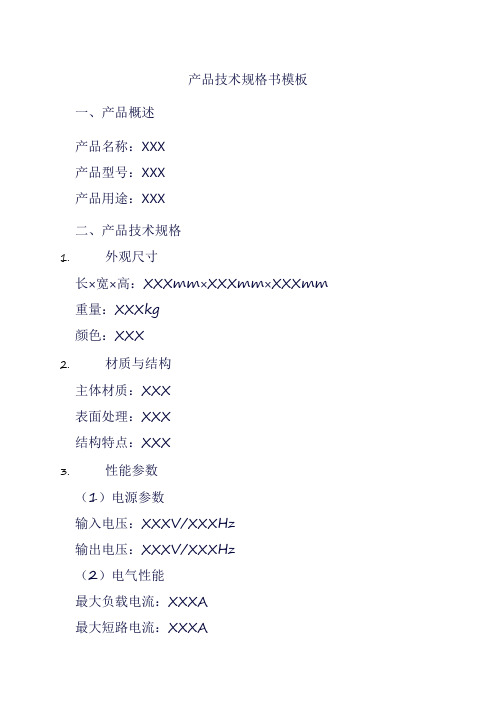
产品技术规格书模板一、产品概述产品名称:XXX产品型号:XXX产品用途:XXX二、产品技术规格1.外观尺寸长×宽×高:XXXmm×XXXmm×XXXmm 重量:XXXkg颜色:XXX2.材质与结构主体材质:XXX表面处理:XXX结构特点:XXX3.性能参数(1)电源参数输入电压:XXXV/XXXHz输出电压:XXXV/XXXHz(2)电气性能最大负载电流:XXXA最大短路电流:XXXA绝缘电阻:XXXMΩ(3)环境适应性工作温度范围:-XXX℃~+XXX℃存储温度范围:-XXX℃~+XXX℃工作湿度范围:XXX%~XXX%存储湿度范围:XXX%~XXX%(4)安全性能防电击类型:XXX防电击保护级别:XXX外壳防护等级:XXX4.接口与通讯(1)输入接口类型:XXX接口数量:XXX个(2)输出接口类型:XXX接口数量:XXX个(3)通讯接口类型:XXX接口(如:以太网、USB、蓝牙等)数量:XXX个传输速率:XXXMbps/s5.电源与功耗(1)电源适配器类型:XXX适配器(如:AC-DC、DC-DC等)输入电压:XXXV/XXXHz输出电压:XXXV/XXXHz最大输出电流:XXXA(2)电池续航能力待机时间:XXX小时工作时间:XXX小时(根据具体使用情况而定)电池类型:XXX电池(如:锂离子电池、镍氢电池等)电池容量:XXXmAh/Ah充电时间:XXX小时/次(根据电池类型和容量而定)6.包装与附件包装材料:XXX(如:纸箱、泡沫等)内附物品:包含以下附件(具体根据产品而定,此处仅为示例):•说明书x1份•保修卡x1份•数据线x1条•电源适配器x1个•产品本体x1台。
(完整word版)技术规格书汇总,推荐文档
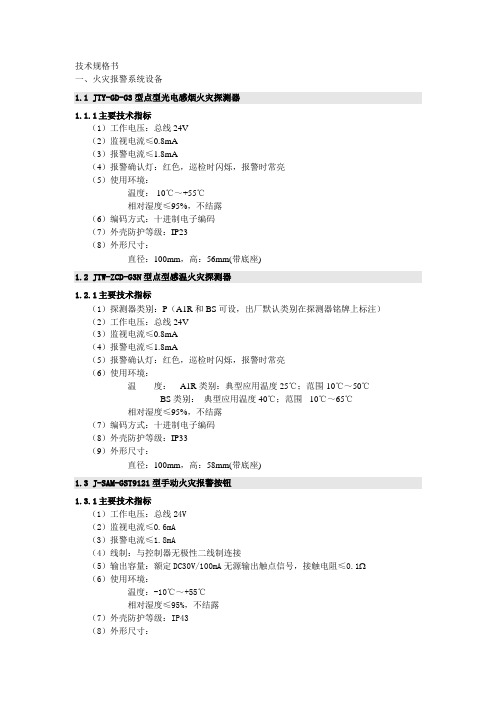
技术规格书一、火灾报警系统设备1.1JTY-GD-G3型点型光电感烟火灾探测器1.1.1主要技术指标(1)工作电压:总线24V(2)监视电流≤0.8mA(3)报警电流≤1.8mA(4)报警确认灯:红色,巡检时闪烁,报警时常亮(5)使用环境:温度:-10℃~+55℃相对湿度≤95%,不结露(6)编码方式:十进制电子编码(7)外壳防护等级:IP23(8)外形尺寸:直径:100mm,高:56mm(带底座)1.2JTW-ZCD-G3N型点型感温火灾探测器1.2.1主要技术指标(1)探测器类别:P(A1R和BS可设,出厂默认类别在探测器铭牌上标注)(2)工作电压:总线24V(3)监视电流≤0.8mA(4)报警电流≤1.8mA(5)报警确认灯:红色,巡检时闪烁,报警时常亮(6)使用环境:温度:A1R类别:典型应用温度25℃;范围-10℃~50℃BS类别:典型应用温度40℃;范围-10℃~65℃相对湿度≤95%,不结露(7)编码方式:十进制电子编码(8)外壳防护等级:IP33(9)外形尺寸:直径:100mm,高:58mm(带底座)1.3J-SAM-GST9121型手动火灾报警按钮1.3.1主要技术指标(1)工作电压:总线24V(2)监视电流≤0.6mA(3)报警电流≤1.8mA(4)线制:与控制器无极性二线制连接(5)输出容量:额定DC30V/100mA无源输出触点信号,接触电阻≤0.1(6)使用环境:温度:-10℃~+55℃相对湿度≤95%,不结露(7)外壳防护等级:IP43(8)外形尺寸:95.4mm×98.4mm×45.5mm (带底壳)1.4J-SAM-GST9123型消火栓按钮1.4.1主要技术指标(1)工作电压:总线24V(2)监视电流≤0.8mA(3)报警电流≤2mA(4)线制:消火栓按钮与火灾报警控制器信号二总线连接,若需实现直接启泵控制,需将消火栓按钮与泵控制箱采用二线连接(5)指示灯启动:红色,巡检时闪亮,消火栓按钮按下时此灯点亮回答:绿色,消防水泵运行时此灯点亮(6)无源输出触点容量:DC30V/100mA(7)使用环境:温度:-10℃~+55℃相对湿度≤95%,不结露(8)外壳防护等级:IP65(9)外形尺寸:95.4mm×98.4mm×52.5mm (带底壳)1.5HX-100B、HX-100B/T型火灾声光警报器1.5.1主要技术指标(1)工作电压:信号总线电压:24V 允许范围:16V~28V电源总线电压:DC24V 允许范围:DC20V~DC28V(2)工作电流:总线监视电流≤0.8mA 总线启动电流≤6.0mA电源监视电流≤10mA 电源动作电流≤90mA(3)线制:四线制,与控制器采用无极性信号二总线连接,与电源线采用无极性二线制连接(4)声压级:80dB~115dB(前方3m水平处(A计权))(5)闪光频率:1.0Hz~1.4Hz(6)变调周期:4s(1±20%)(7)声调:火警声(8)使用环境:温度:-10℃~+50℃相对湿度≤95%,不结露(9)外壳防护等级:IP43(10)执行标准:GB 26851-2011(11)外形尺寸:90mm×144mm×60.5mm(带底壳)1.6GST-LD-8300型输入模块1.6.1主要技术指标(1)工作电压:总线24V(2)工作电流≤1mA(3)线制:与控制器的信号二总线连接(4)出厂设置:常开检线方式(5)使用环境:温度:-10℃~+55℃相对湿度≤95%,不结露(6)外壳防护等级:IP30(7)外形尺寸:86mm×86mm×43mm(带底壳)1.7GST-LD-8301型输入/输出模块1.7.1主要技术指标(1)工作电压:总线电压:总线24V电源电压:DC24V(2)监视电流:总线电流≤1mA电源电流≤5mA(3)动作电流:总线电流≤3mA电源电流≤20mA(4)线制:与控制器采用无极性信号二总线连接,与DC24V电源采用无极性电源二总线连接(5)无源输出触点容量:DC24V/2A,正常时触点阻值为100kΩ,启动时闭合,适用于12V~48V直流或交流(6)输出控制方式:脉冲、电平(继电器常开触点输出或有源输出,脉冲启动时继电器吸合时间为10s)(7)出厂设置:常开检线输入、无源输出方式(8)使用环境:温度:-10℃~+55℃相对湿度≤95%,不结露(9)外壳防护等级:IP30(10)外形尺寸:86mm×86mm×43mm(带底壳)1.8GST-LD-8313型隔离器1.8.1主要技术指标(1)工作电压:总线24V(2)动作电流≤100mA(3)动作确认灯:黄色(4)使用环境:温度:-10℃~+50℃相对湿度≤95%,不结露(5)外壳防护等级:IP30(6)外形尺寸:86mm×86mm×43mm(带底壳)1.9ZF-500型火灾显示盘1.9.1主要技术指标(1)显示方式:可显示报警时间、设备号、设备类型、注释信息(2)显示容量:最多不超过126条汉字报警信息(3)线制:与火灾报警控制器间采用有极性二总线连接,另需两根DC24V电源供电线(不分极性)(4)使用环境:温度:0℃~+40℃相对湿度≤95%,不结露(5)电源:采用DC24V电源集中供电(6)静态功耗≤2W,最大功耗≤5W(7)外形尺寸:206mm×115mm×44mm1.10J B-QB-GST500型火灾报警控制器(联动型)1.10.1主要技术指标(1)液晶屏规格:320×240图形点阵,可显示12行汉字信息(2)控制器容量:a.可带二个242地址编码点回路,最大容量为484个地址编码点b.可外接64台火灾显示盘;联网时最多可接32台其它类型控制器c.64个直接手动操作总线制控制点d.最大可配置10路直接控制点(3)线制:a. 控制器与探测器间采用无极性信号二总线连接,与各类控制模块间除无极性二总线外,还需外加二根DC24V电源总线b. 与其它类型的控制器采用有极性二总线连接,对于火灾报警显示盘,需外加两根DC24V电源供电总线c. 与彩色CRT系统采用四芯扁平电话线,通过RS-232标准接口连接,最大连接线长度不宜超过15md. 直接控制点与现场设备采用三线连接(4)使用环境:温度:0℃~+40℃相对湿度≤95%,不结露(5)电源:主电为交流220V+10%-15%,内装DC24V 14Ah密封铅电池作备电(6)监控状态功耗≤55W,火警状态最大功耗≤70W(7)最大接线长度≤1000m1.主要技术指标(1)额定输出容量:DC24V、6A(2)使用环境:温度:0℃~+40℃相对湿度≤95%,不结露(3)电源:主电为交流220V+10%-15%, DC24V 24Ah密封铅电池作备电(4)外形尺寸:484mm⨯89mm⨯325mm2.1主要技术指标1)工作电压:交流AC220V 50/60Hz ,允许电压变化范围 AC176V~AC264V;2)功耗:监视状态功耗≤20W;最大功耗≤150W;3)备用电源:2个DC12V/7Ah密封铅电池;4)气体喷洒输出:DC24V/3A,脉冲方式/持续方式,可调;5)辅助24V电源输出:最大0.6A;6)电池充电电流:0.6A~0.8A;7)液晶屏规格:128×64点,可同屏显示32个汉字信息;8)容量可带1个区的气体灭火设备,实现对1个防护区的保护。
技术规格书doc
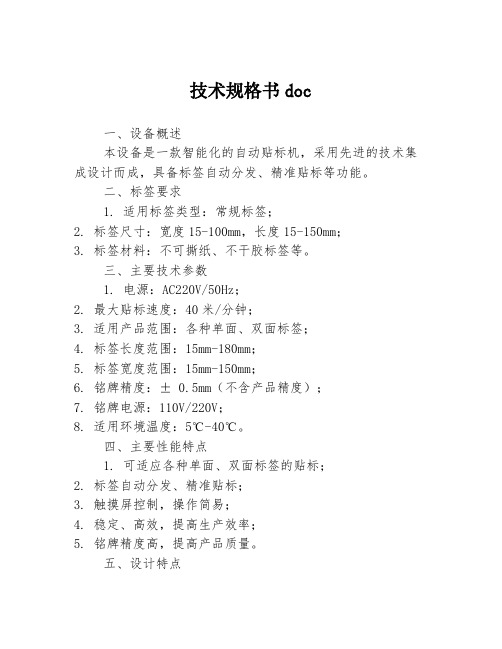
技术规格书doc
一、设备概述
本设备是一款智能化的自动贴标机,采用先进的技术集成设计而成,具备标签自动分发、精准贴标等功能。
二、标签要求
1. 适用标签类型:常规标签;
2. 标签尺寸:宽度15-100mm,长度15-150mm;
3. 标签材料:不可撕纸、不干胶标签等。
三、主要技术参数
1. 电源:AC220V/50Hz;
2. 最大贴标速度:40米/分钟;
3. 适用产品范围:各种单面、双面标签;
4. 标签长度范围:15mm-180mm;
5. 标签宽度范围:15mm-150mm;
6. 铭牌精度:± 0.5mm(不含产品精度);
7. 铭牌电源:110V/220V;
8. 适用环境温度:5℃-40℃。
四、主要性能特点
1. 可适应各种单面、双面标签的贴标;
2. 标签自动分发、精准贴标;
3. 触摸屏控制,操作简易;
4. 稳定、高效,提高生产效率;
5. 铭牌精度高,提高产品质量。
五、设计特点
1. 采用先进的传感器和控制系统,智能化程度高;
2. 采用高品质的材料,厚度均匀,操作稳定;
3. 设计合理,方便用户进行操作和维护。
六、应用场景
该设备广泛应用于食品、医药、日化等行业的标签贴附。
七、售后保障
1. 提供一年质保服务,为用户提供免费保修;
2. 设备出现故障,24小时内,提供技术支持和培训服务;
3. 坚持以用户为中心,服务企业、服务社会。
技术规格书及数据单
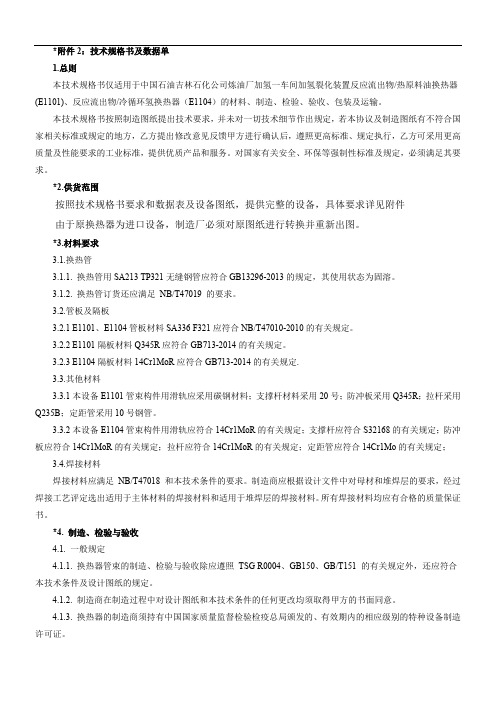
*附件2:技术规格书及数据单1.总则本技术规格书仅适用于中国石油吉林石化公司炼油厂加氢一车间加氢裂化装置反应流出物/热原料油换热器(E1101)、反应流出物/冷循环氢换热器(E1104)的材料、制造、检验、验收、包装及运输。
本技术规格书按照制造图纸提出技术要求,并未对一切技术细节作出规定,若本协议及制造图纸有不符合国家相关标准或规定的地方,乙方提出修改意见反馈甲方进行确认后,遵照更高标准、规定执行,乙方可采用更高质量及性能要求的工业标准,提供优质产品和服务。
对国家有关安全、环保等强制性标准及规定,必须满足其要求。
*2.供货范围按照技术规格书要求和数据表及设备图纸,提供完整的设备,具体要求详见附件由于原换热器为进口设备,制造厂必须对原图纸进行转换并重新出图。
*3.材料要求3.1.换热管3.1.1. 换热管用SA213 TP321无缝钢管应符合GB13296-2013的规定,其使用状态为固溶。
3.1.2. 换热管订货还应满足NB/T47019 的要求。
3.2.管板及隔板3.2.1 E1101、E1104管板材料SA336 F321应符合NB/T47010-2010的有关规定。
3.2.2 E1101隔板材料Q345R应符合GB713-2014的有关规定。
3.2.3 E1104隔板材料14Cr1MoR应符合GB713-2014的有关规定.3.3.其他材料3.3.1本设备E1101管束构件用滑轨应采用碳钢材料;支撑杆材料采用20号;防冲板采用Q345R;拉杆采用Q235B;定距管采用10号钢管。
3.3.2本设备E1104管束构件用滑轨应符合14Cr1MoR的有关规定;支撑杆应符合S32168的有关规定;防冲板应符合14Cr1MoR的有关规定;拉杆应符合14Cr1MoR的有关规定;定距管应符合14Cr1Mo的有关规定;3.4.焊接材料焊接材料应满足NB/T47018 和本技术条件的要求。
制造商应根据设计文件中对母材和堆焊层的要求,经过焊接工艺评定选出适用于主体材料的焊接材料和适用于堆焊层的焊接材料。
技术规格书(格式)
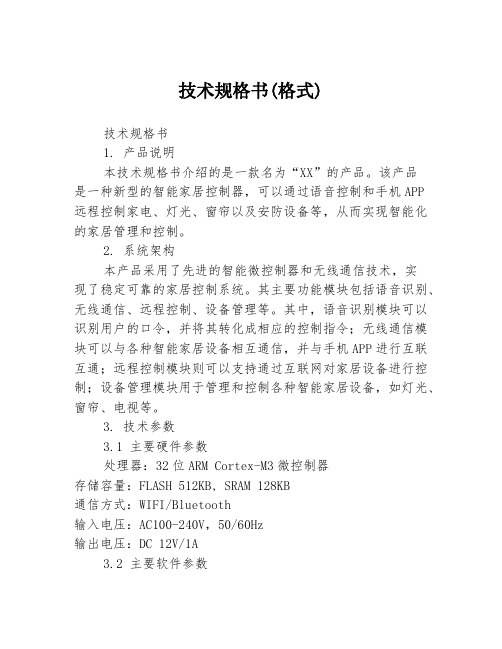
技术规格书(格式)技术规格书1. 产品说明本技术规格书介绍的是一款名为“XX”的产品。
该产品是一种新型的智能家居控制器,可以通过语音控制和手机APP远程控制家电、灯光、窗帘以及安防设备等,从而实现智能化的家居管理和控制。
2. 系统架构本产品采用了先进的智能微控制器和无线通信技术,实现了稳定可靠的家居控制系统。
其主要功能模块包括语音识别、无线通信、远程控制、设备管理等。
其中,语音识别模块可以识别用户的口令,并将其转化成相应的控制指令;无线通信模块可以与各种智能家居设备相互通信,并与手机APP进行互联互通;远程控制模块则可以支持通过互联网对家居设备进行控制;设备管理模块用于管理和控制各种智能家居设备,如灯光、窗帘、电视等。
3. 技术参数3.1 主要硬件参数处理器:32位ARM Cortex-M3微控制器存储容量:FLASH 512KB, SRAM 128KB通信方式:WIFI/Bluetooth输入电压:AC100-240V,50/60Hz输出电压:DC 12V/1A3.2 主要软件参数操作系统:RTOS支持语音识别语言:中文、英文支持远程控制方式:互联网控制、手机APP远程控制4. 功能介绍4.1 语音识别本产品支持中文和英文语音识别。
用户可以使用口令语音控制各种智能家居设备,如开启电灯、关闭窗帘、调节温度等。
语音识别技术采用了高性能的语音识别算法,可以实现较高的识别准确率。
4.2 远程控制本产品支持远程控制,用户可以通过手机APP或者互联网对家庭智能设备进行控制,无需离开座位。
同时,远程控制模块还支持定时开关等各种智能控制功能。
4.3 设备管理本产品可以管理各种智能家电,如照明、空调、窗帘等。
用户可以通过手机APP或语音控制对其进行管理和控制。
4.4 安全功能本产品采用了先进的加密技术,可以有效防止用户信息泄漏和非授权访问。
同时,为了保证产品的稳定性和可靠性,本产品也采用了多层次的数据备份和数据恢复技术。
船舶技术规格书常用条款描述汇总概要
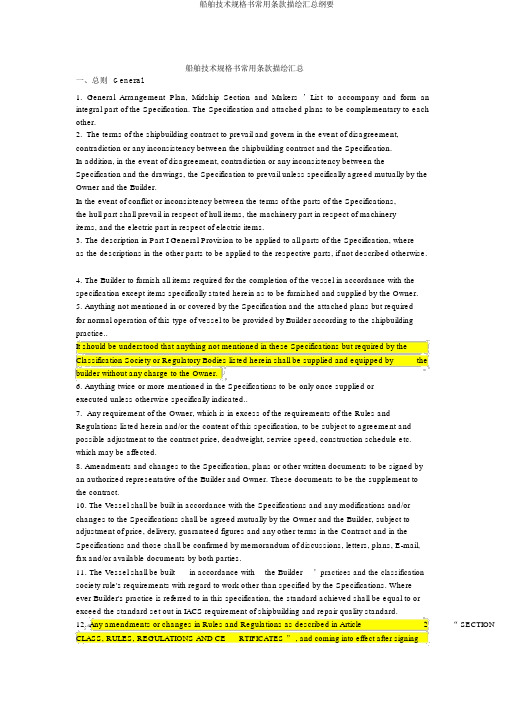
船舶技术规格书常用条款描绘汇总一、总则General1.General Arrangement Plan, Midship Section and Makers ’List to accompany and form anintegral part of the Specification. The Specification and attached plans to be complementary to eachother.2.The terms of the shipbuilding contract to prevail and govern in the event of disagreement,contradiction or any inconsistency between the shipbuilding contract and the Specification.In addition, in the event of disagreement, contradiction or any inconsistency between theSpecification and the drawings, the Specification to prevail unless specifically agreed mutually by theOwner and the Builder.In the event of conflict or inconsistency between the terms of the parts of the Specifications,the hull part shall prevail in respect of hull items, the machinery part in respect of machineryitems, and the electric part in respect of electric items.3.The description in Part I General Provision to be applied to all parts of the Specification, whereas the descriptions in the other parts to be applied to the respective parts, if not described otherwise.4.The Builder to furnish all items required for the completion of the vessel in accordance with thespecification except items specifically stated herein as to be furnished and supplied by the Owner.5.Anything not mentioned in or covered by the Specification and the attached plans but requiredfor normal operation of this type of vessel to be provided by Builder according to the shipbuildingpractice..It should be understood that anything not mentioned in these Specifications but required by theClassification Society or Regulatory Bodies listed herein shall be supplied and equipped by thebuilder without any charge to the Owner.6.Anything twice or more mentioned in the Specifications to be only once supplied orexecuted unless otherwise specifically indicated..7.Any requirement of the Owner, which is in excess of the requirements of the Rules andRegulations listed herein and/or the content of this specification, to be subject to agreement andpossible adjustment to the contract price, deadweight, service speed, construction schedule etc.which may be affected.8.Amendments and changes to the Specification, plans or other written documents to be signed byan authorized representative of the Builder and Owner. These documents to be the supplement tothe contract.10.The Vessel shall be built in accordance with the Specifications and any modifications and/orchanges to the Specifications shall be agreed mutually by the Owner and the Builder, subject toadjustment of price, delivery, guaranteed figures and any other terms in the Contract and in theSpecifications and those shall be confirmed by memorandum of discussions, letters, plans, E-mail,fax and/or available documents by both parties.11. The Vessel shall be built in accordance with the Builder’practices and the classificationsociety rule's requirements with regard to work other than specified by the Specifications. Whereever Builder's practice is referred to in this specification, the standard achieved shall be equal to orexceed the standard set out in IACS requirement of shipbuilding and repair quality standard.12. Any amendments or changes in Rules and Regulations as described in Article 2 “ SECTION CLASS, RULES, REGULATIONS AND CE RTIFICATES ” , and coming into effect after signingthe Contract, is to be treated as a modification to the Contract and to be subject to separate negotiations between the Owner and the Builder.13.During approval of plans, both parties agree to a design which differs from the specifications, it is understood that terms in the specifications concerning these alterations would be no longer applicable. Consequently in theses cases, the drawings shall be approved by the owner and the approved drawings shall supplement to the specifications.14.Spare parts shall be supplied by the Builder according to the Specifications to meet the requirements of the specified Classification Society, the regulatory bodies and manufacturer’ s standard.15. Parts and components of equipment made under license to be interchangeable with parts/components produced/installed as per original maker’ s standard.16. Builder’ s practice shall be submitted to Buyer for reference.17. When words such as“ or” ,“ and/or” ,“ if necessary” ,“ if any” ,“ similar Specifications, they shall be to indicate that the use of alternatives is permitted at the Builderoption.18.During the tests and trials, the Builder may use some of the supplied spare parts, tools, and accessories to the vessel if necessary, and the Builder shall furnish them from the originalmanufacture before delivery.19.All necessary documents and drawings for construction of the vessel shall be prepared in English or in English and other language for approval by the Buyer, classification society and authorities.20.The meaning of “ theBuyer ”in the Contract or “ theOwner” in the Specification shall be understood to be the same.21.All figures given in the Specification shall be understood as approximate ones and determinedin accordance with the design development except those which are of countable nature, unlessotherwise specifically described in the Specification.二、资料Materials1. If any specified article or material cannot be obtained or supplied, the Builder to have the rightto select suitable substitutes with Owner’ s approval.2. Materials, machinery and equipment, etc. to be of Chinese maker unless specifically agreedand/or described in the Specifications and the Makers’ List.3.All structural steel used for the construction of the vessel and machinery including forgings and castings to be of the shipbuilding and marine engineering quality, tested, inspected and certified asand when required by the Classification Society.4.Minimizing the use of materials known to be potentially hazardous to health and the environment, especially asbestos, refrigerants (R12/ R22), HALON. Lead-based paint and Tin-based anti-fouling paint to be not used.5.Stainless steel without grade notation in the Specification shall be understood as marine typeminimum grade SUS 304.6.If any of the specific description for the machinery or equipment in the Specification is notconsistent with the finally selected manufacturer's standard Specification, such description shall bereadily corrected to follow the manufacturer's standard Specification with prior notice to the Owner; however in no case these shall be less in performance than described in the Specification.” , “ may ’ s船舶技术规格书常用条款描绘汇总纲要7.New, first class materials etc. shall be used, with a quality suitable for this type and size of Vessel, adapted to world-wide operation.三、工艺及标准Workmanship & Standards1.All workmanship entering into the construction of the vessel to be in accordance with the Chinese ship building standards and/or Builder's standard practice, applicable to this kind of vessel, subject to the approval of the Classification Society where necessary. The standards of Builder's practice to be submitted to the Owner for reference.2. The following standards to be applied to the construction of the vessel, as far as practicable except the fittings specially described hereinafter.a)ISO standardb)Chinese industrial standards (GB, CSQS, CB, YB, etc.)c)Builder's standards, and Builder's standard practiced)IECe)IACS 47, part A: shipbuilding and repair quality standard for new construciton3.International System of Units (SI) to be adopted for designing and constructing of hull, machinery and equipment unless specifically stated in this Specification.四、船东供品(Owner ’s supply)1. Following items to be furnished and supplied by the Owner at their own expense, and installedon the vessel by the Builder. The Builder to provide sheltered and secure storage, handling in storage and handling on-board.-Mooring ropes in excess of the Specification-All air tools, hoses, steel wires, etc. other than those mentioned in the Specification-All charts, nautical and radio station books, house flag and national flag-All consumable stores-All medicine , medical equipment and oxygen bottle for hospital except those for life boat-Recreation equipment such as Stereophony, Video tape recorder and TV etc and stationery other than mentioned in the Specification-Painting and pictures- Boatswain's and carpenter's tools over and above the Builder’ s standard-All bedding and linen (blankets, sheets, covers, etc.) but excluding mattress.-All napery (serviettes, table clothes, etc.)-All cook's and steward's utensils (crockery, cutlery, silverware, earthenware, glasses, pots, pans, etc.-Typewriters, copy machine-Loose lashing/securing fittings for cargoes-Suez Canal searchlight, but socket and davit to be supplied by builder-Navigation equipment in excess of those required by the authorities and/or those specified inthis Specification-Cargo handling equipment such as grabs (including the control devices) etc.-Personal computer-All bunkers, lubricants, grease/hydraulic oil, working oil and other consumable liquid except those consumed during construction and test/trials before delivery. The Owner to supply lub. oil船舶技术规格书常用条款描绘汇总纲要for sea trials and the Builder to pay the cost for the quantities of lub. oil consumed during the trials.-All other spare, store and equipment in excess of Rule and Specification requirements and maker'sstandard, unless maker agrees to supply additional spares free of charge after agreement withOwner/Builder.-Gas sampling device and temperature measuring device for cargo hold-Gymnastic and Sport apparatus/equipment, except specified in other parts of this specification-Chemistry deposit-The hazardous gas detection equipment and personal protection for carriage of dangerous cargo.-Portable wash cleaning machine for cargo hold-Garbage cans-Necessary number of operating tools for helicopter winching if required-Cable for shore connection-Fire ropes for Suez Canal-Articles specified as "Owner's supply" in other parts of this specification-Lifting Beams 对多用途船2.The Owner shall furnish the Builder with necessary specifications, plans, drawings, instructionbooks, manuals, test reports, certificates, the manufacturer's service engineer(s), etc. as requiredby the Builder, which shall form an integral part of the Owner?s supplies.3. Commissioning for good working order of the Owner?s supplied equipment during and afterinstallation on board shall be carried out by the Owner or person(s) designated by the Ownerin accordance with the construction schedule of the Vessel.The expenses related with commissioning shall be the Owner ?s account.4.All Owner's supplies to be sent to the Builder ?s shipyard by Owner at Owner ?s costs at the timedesignated by the Builder in a condition ready for installation costs such as transportation, customsinspection fees, etc. shall be borne by the Owner.五、规范及规则Rules and Regulations1.The latest Rules with amendments and Regulations listed as following including any circular,’ s contract s amendments which are in force before and at the date of the signing of the shipapplied.2.The rules and requirements shall be understood to include all amendments, supplements andchanges thereto which shall have been published by the date of contract for construction of thevessel and which shall have become compulsorily applicable to the vessel by reason of the date ofcontract.1)Rules and Regulations of Classification Society2)Maritime laws and regulations of flag authority3)International rules and regulations-International Convention on Load Lines (1966) including all and latest amendments-International Convention for the Safety of Life at Sea (SOLAS 1974) including all andlatest amendments-International Convention for the Prevention of Pollution from Ships 1973 (MARPOL 1973)with protocol 1978 and all amendments, including Annexes I, IV, V, VI,and including IMOResolution MEPC.203(62) regulation on EEDI and SEEMP.-International Regulations for Preventing Collisions at Sea (London 1972) including latest revision-International Tele-communication convention with amendments including watch keeping receiver (Geneva 1976) and radio regulation-International Regulation on Tonnage Measurement of ships, 1969-MLC Maritime Labour Convention, 2006 , Regulation 3.1 mandatory requirements-2008 IS Code –International Code on Intact Stability, 2008-IMO Resolution MSC. 23 (59) (International Grain Code)- IMO Resolution MSC. 137 (76)“ Standards for Ship Maneuverability“-IMO Resolution MSC. 215 (82) (PSPC)-IMO Resolution A. 868 (20) “ Guidelinesfor the control and management of ships ’ballast“water to minimize the transfer of harmful aquatic organisms and pathogens- IMSBC Code –International Maritime Solid Bulk Cargoes Code 散货船-All IACS Unified Requirements for strength applicable to New Building of Bulk Carrier which has been formal published at the date of signing contract including UR S1A, S21, S24,- SOLAS resolution II-1/3-6 regarding PMA. (散货船)- International marine pilots association requirements for pilot ladder--IMO resolution A468 (XII) code of noise level on board ships-ISO 6954 guidelines for vibrations on board ships- AFS - International Convention on the Control of Harmful Anti-Fouling Systems on Ships, 2001- ISPS code only fixed equipment- Hong Kong International Convention for the Safe and Environmentally Sound Recycling of Ships, 2009.( 未奏效 )4)Special rules and regulations-Rules and Regulations governing navigation of Suez Canal, including tonnage measurement-Rules and Regulation governing navigation of the Panama Canal including tonnage measurement-U.S. Coast Guard Regulations applying to foreign flag vessel trading in U.S. waters concerning pollution prevention (CFR Title 33-Part 155, 159 for pollution and 164 for safetyof navigation without certificate)- Australian Maritime Safety Authority MARINE ORDERS Part 32 “ Cargo Handl ing Equipment ” preparedon 29 November 2011 (for ladders in cargo hold/deck)-European Union Council directive 2005/33/EC amending 1999/32/EC of 26 April 1999 and, in relating to introduce 0.1% sulfur limit for marine fuel.-U.S. Department of Labor Occupational Safety and Health Administration (OSHA ) rules, Safety and Health Regulations for Longshoring (espec. CFR, Title 29) (集装箱船)-Kiel Canal Regulations-Great Lakes & St. Lawrence Seaway Regulations-Marine Equipment Directive (MED) 2011/75/EU of 2 September 2011, amending CouncilDirective 96/98/EC on marine equipment六、证书Cerfificates1.The Builder to obtain following certificates and deliver to the Owner at the time of Vessel's delivery.Each certificate to be delivered in triplicate, one (1) as original and two (2) as counterparts at deliveryof the Vessel.Certificates Issued by Classification Certificate 入级证书Classification Society ICLL 1966 International Load Line Certificate Classification Society Approval of Stability on behalf of flag (declaration will be issued) Classification SocietyCargo Ship Safety Equipment Certificate Classification Society SOLAS Cargo Ship Safety Construction Certificate Classification Society Cargo Ship Safety Radio Certificate Classification SocietyPassenger Ship Safety Certificate Classification SocietyGrain Loading Declaration (Certificate) Classification SocietyIOPP-B--- International Oil Pollution Prevention Certifidate Classification Society(Annex I) –B (Oil Tanker)IOPP-A--- International Oil Pollution Prevention Certifidate Classification Society MARPOL (Annex I) –A (other ship)73/78 NLS-07--- International Certificate for the Carriage of Noxious Classification Society Liquid Substances in BulkISPP---International Sewage Pollution Prevention Certificate (IV) Classification SocietyGPP---Statement of Garbage Pollution Prevention from ships(V) Classification SocietyIAPP---International Air Pollution Prevention (VI) Classification SocietyEIAPP---International Air Pollution Prevention (VI) –for ME/GE Classification Societyand incineratorInternational tonnage certificate (1969) Classification Society Tonnage Panama Canal PC/UMS documentation Classification Society Suez Canal tonnage Classification Society BWM---Certificate of Compliance with the international Ballast Water Management Classification Society ConventionIBC Code---International Certificate of Fitness for carriage of dangerous chemicals Classification Society in bulk 国际散装运输危险化学品适装证书IGC Code--- International certificate of Fitness for carriage of liquefied gases in bulk Classification Society 国际散装运输液化气体适装证书IMSBC Code — Certificate of compliance for the carriage of IMSBC Code appendex Classification Society A,B,C Cargoes as per ship designMODU---IMO MODU Code certificate Classification Society ILO152--- Certificate for Cargo Gear 起货设施证书Classification Society ILO92/133---Certificate of inspection of crew accommodation 海员舱室设施查验Classification SocietyMLC 2006 Certificate Classification Society IAFS ---international Anti-fouling Systems Certificate 国际防污底系统切合证书AFS -- Anti-fouling Systems Statement of Compliance 防污底系统切合证明Classification Society SPS Code---Special purpose ship safety certificate 特种用途船安全证书Classification Society USVCS---Certificate of Compliance Marine Vapour Control System- U.S. Classification Society RegulationUSCG---Declaration concerning compliance with USCG Navigation Regulations Classification Society (Title 33, Part 164)USCG---Declaration concerning USCG Pollution and Sanitation Regulations (Title Classification Society 33, Part 155 and /or 159)Declaration of Survey regarding compliance with Panama Canal regulations Classification Society Declaration of Survey regarding compliance with St. Lawrence Seaway Regulation Classification Society Declaration of Survey regarding compliance with Sues Canal Authority Regulation Classification Society Arctic Pollution Prevention Certificate Classification Society IDG-B---Document of Compliance Special requirements for ships carrying Classification Society dangerous goods- Bulk cargoIDG-P---Document of Compliance Special requirements for ships carrying Classification Society dangerous goods- Packaged cargoPCL-Personal and Cargo Lift Certificate Classification Society Inventory of Hazardous Material (Green passport) Statement of Compliance Classification Society Approved Documents for intact stability Classification SocietyApproved Documents for Damage Stability Classification Society Documents Approved Inclining test report / or deadweight measurement report Classification Society (Builder) Approved Loading Manual Classification Society Approved Grain Loading Manual Classification SocietyApproved Ballast Water Management Plans Classification SocietyApprove Damage Control Plan Classification SocietyApproved Fire Control and Safety Plan Classification SocietyApproved SOPEP Classification Society Documents Approved Cargo Securing Manual Classification Society (Owner) Approved Training Manual Classification Society Approved Garbage Plan Classification SocietyApproved ISPS Manual Classification Society Classification Certificate for all equipments, to extend required by Classification Classification Society Society or AuthoritiesDeratization Exemption Certificate 灭鼠免去证书Assigned Authority Magnetic Compass adjustment Certificate Classification Societyor authorized body Report on chemical examination for cargo hold paint Authorize party Potable Water Certificate Authorize party AMSA--- Drawings approved by AMSA to certify compliance with AMSA Authority requirementBuilder ’s Certificate BuilderDeadweight Certificate BuilderAsbestos absence certificate 无石棉证书BuilderPCB free certificate 无多氯联笨证书BuilderTBT free certificateCertificate of nationality 国籍证书Flag AuthorityOwner Supply Minimum Safe Manning Certificate 最低安全配员证书Flag AuthorityShip Radio Communication License 船舶无线电通讯允许Flag AuthorityCertificates for Masters, Officers or Ratings 海员证书Authorize partySafety Management Certificate2.However if formal certificate(s) cannot be obtained at the ship ’delivery,s Builder to furnishprovisional certificate(s) to the Owner which substitutes the formal certificate(s). In such case,Builder to deliver formal c ertificate(s) to Owner as soon as practicable after the ship’ s delivery but in any case prior to the expiration of the validity of the provisional certificate(s).七、监造、查验、试验及试航Supervision,Inspections, Tests and Trials1.Tests and trials to be carried out in accordance with the requirement of the classification societyand according to the Builder's usual standard practice in the presence of the surveyor of theClassification Society and the Owner's and the Builder's representatives.The Owner has the right to appoint one or more Supervisors for the supervision during constructionand execution of works in accordance with the Shipbuilding Contract. During the building period, theBuilder shall allow Owner's Supervisor to enter the yard during working hoursfor the purpose of supervision and the Builder also shall negotiate with his sub-Contractors thatthe Supervisor may attend during construction and testing of major equipment atsubContractors' sites.The supervisor to have access to all places and offices which are related to the design andconstruction of the Vessel.The Builder shall give necessary information such as schedule of building, tests and workingdrawings as well as assistance including two suitably furnished offices with writing desks, chairs,refrigerators, heaters and air conditioning, lamps, cupboards, shelves and including internaltelephone and a direct international telephone line with fax- and e-mail connection to enable Owner'srepresentatives to effect the supervision. The costs for telecommunication will be to Owner?saccount.2.The Builder will inform the supervision about the building schedules, test and working drawings.Schedules for daily inspections will be handed over to the supervision one day inadvance except the inspection for painting work in emergency condition. Information about testsof equipment (date and program) will be handed over to the supervision three days before tests willtake place. If the Owner can not attend inspections for reasons of their own after being givenreasonable notice, the inspection and test would be entrusted to surveyor of the ClassificationSociety and/ or the Builder ’s inspector or the paint manufacturer or the equipment maker’srepresentative, and the results to be accepted by the Owner.3. Inspection of hull structureAll steel structures to be inspected and tightness to be tested for tanks, bulkheads, superstructures,decks and other wet spaces as required by the Rules.Tanks to be tested hydrostatically or by air as required by the Rules. X-ray photographs or ultrasonicto be taken mainly from cross-points of seams and butts of block assemblies of bottom shell, bilge strake, main deck and sheer strake as required by the Rule. Additional 10% X- ray photographs tobe appointed and checked by the Owner’ ssupervisor. Castings of stern frame and rudder to betested by magnaflux or equivalent.Temporary pieces such as staging pieces, lifting lugs and their reinforcements located in the fatigue sensitive area, high stressed area or passage way shall be treated without leaving notchesaccording to the Builder ?s practice. However those pieces considered not inconvenient for thefuture service may remain as the Builder ?s practice.4. Block inspectionThe block inspection to be carried out after completion of hull block steel works. Even if fittingsare fitted wholly or partially to the hull blocks, the inspection for the hull blocks to be carried outwithout dismantling such fittings unless the block inspection is obstructed by such fittings.The internal inspection for hull construction works of tanks, engine room, etc. to be carried outeven if outfitting works in such spaces have not been finished yet but any works in connectionwith strength and tightness of the hull construction to be completed before the said inspection, inwhich case, after completion of the outfitting works, final inspection of such parts to be made in accordance with the “ Item of inspection and testing “ mutually agreed between the Owner and the Builder.5. Shop testsShop tests for main engine, auxiliary machinery, deck machinery, motors etc. to be performed in accordance with the Rule requirements and/or the standard of the makers by the manufacturersat their shops.Test results of major machinery and equipment shall be furnished to the Owner in triplicate.The Owner shall be informed of the shop test schedule at least fourteen(14) days for foreign Maker (outside China) and seven(7) days for domestic Maker in advance of the expected date of the shoptests and the Owner's attendance shall be confirmed to the Builder four(4) days in advance of the expected date of the shop test.The Owner ’ s representatives will join the shop tests ofmain equipment. The travel cost and hotelcost outside China for Owner ’s representatives will be born by Owner.6. Installation and equipmentInstallation and equipment to be tested on board the vessel in accordance with the requirements ofthe Classification Society and/or Regulatory Bodies and the standard protocol of the Builder. Test protocol to be approved by the Owner.The structure, fittings, machinery and electrical installations to be tested after installation on boardto demonstrate satisfactory workmanship, proper working, alignment of moving parts, suitabilityfor the purpose intended and in compliance with rules and regulations.7. Piping testsWorking tests to be carried out after completion of the piping system. Pressure tests of pipingsystems to be conducted as per requirement of the Classification Society and normal shipbuilding practice.8. Light Ship weight measurement and Inclining testWhen the vessel is substantially completed except minor items of work, inclining test or deadweight measurement of the vessel to be carried out by the Builder near the pier. The incliningtest scheme to be submitted to the Owner for approval. The inclining test to be conducted in calmwater without strong current and strong winds.The light ship weight measurement to be carried out by reading the draught of the vessel, bymeasuring specific gravity of water and by an investigation of weights to be added or to bededucted in the presence of the Owner’ s representatives or the person authorized by the Owner.The draught of the vessel to be measured at both sides of stem, stern and midship draught marks.Displacement of the vessel to be measured from the hydrostatic curves. All measurements andcorrection to be made as per international standard.If any superfluous weight is on board the vessel or any item belonging to the light ship weight isnot on board the vessel at the time of the light ship weight measurement, such a weight to beadjusted later.The calculation of the light ship weight and deadweight to be made by the Builder and verified bythe Owner’ sand Classification representatives in order to determine “ light ship weight “and“ deadweight“ .The incl ining test to be carried out in the presence of the Owner’ s representatives or the person authorized by the Owner and the Classification Society’surveyor, and then the position of thecentre of gravity of the vessel in lightship condition to be determined by the calculation based onthe results of the inclining experiment.The results of the experiment shall be submitted to the Classification Society or other assignedAuthority for approval.The inclining test to be done for first ship of the series only.For subsequent Vessels of a series, the inclining experiment may be deleted in agreement withthe Classification Society. In this case, the results of the first Vessel shall be referred to.9. Mooring trialsMooring tests to be conducted after vessel is substantially complete and prior to the sea trial.Procedure for mooring test of the vessel to be as per Builder ’ s standard. After the mooring trialof main engine the crankcase shall be inspected and crankshaft deflection measured. All mainbearing top/bottom clearance shall be checked and all records to be submitted to Owner ’ srepresentative.10. Sea TrialsWhen the vessel is substantially completed, i.e. major mooring trials finished except minor itemswhich can be carried out on or after sea trial, defects remedied, all equipment and outfitting in sailingcondition and painting work almost completed, sea trial to be performed by the Builder.Only HFO and MDO will be used during sea trial.Main engine to use heavy fuel oil abt. 380 cSt/50 ℃ during sea trial except otherwise specified.All H.F.O., D.O., L.O. for commissioning and testing and L.O. in system to be paid by yard.Detailed scheme for sea trials to be submitted to the Owner for approval at least two weeks priorto sea trials.Reports of sea trial to be submitted to the Owner.。
技术规格书doc3篇
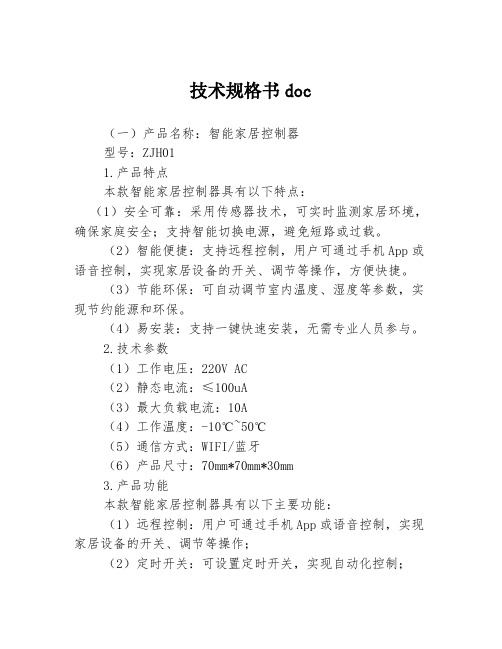
技术规格书doc(一)产品名称:智能家居控制器型号:ZJH011.产品特点本款智能家居控制器具有以下特点:(1)安全可靠:采用传感器技术,可实时监测家居环境,确保家庭安全;支持智能切换电源,避免短路或过载。
(2)智能便捷:支持远程控制,用户可通过手机App或语音控制,实现家居设备的开关、调节等操作,方便快捷。
(3)节能环保:可自动调节室内温度、湿度等参数,实现节约能源和环保。
(4)易安装:支持一键快速安装,无需专业人员参与。
2.技术参数(1)工作电压:220V AC(2)静态电流:≤100uA(3)最大负载电流:10A(4)工作温度:-10℃~50℃(5)通信方式:WIFI/蓝牙(6)产品尺寸:70mm*70mm*30mm3.产品功能本款智能家居控制器具有以下主要功能:(1)远程控制:用户可通过手机App或语音控制,实现家居设备的开关、调节等操作;(2)定时开关:可设置定时开关,实现自动化控制;(3)安全监测:可实时监测家居温度、湿度、空气质量等参数,确保家庭安全;(4)场景模式:支持各种场景模式,如“回家模式”、“离家模式”、“睡眠模式”等。
(二)产品名称:智能门锁型号:ZJH021.产品特点本款智能门锁具有以下特点:(1)安全可靠:采用高精度指纹识别技术,可识别5000个指纹,能有效防止非法进入;(2)多种开锁方式:支持指纹、密码、卡片、机械钥匙等开锁方式,方便快捷;(3)智能便捷:支持远程控制,用户可通过手机App或语音控制,实现开锁、授权、密码修改等操作,方便快捷;(4)节能环保:采用节能设计,可省去电池更换的繁琐;(5)易安装:支持普通门锁一键替换,无需专业人员参与。
2.技术参数(1)工作电压:4.5V DC(3节AA电池)(2)最大负载电流:≤150mA(3)材质:不锈钢(4)通信方式:WIFI/蓝牙(5)产品尺寸:230mm*70mm*22mm3.产品功能本款智能门锁具有以下主要功能:(1)指纹识别:采用高精度指纹识别技术,可识别5000个指纹;(2)多种开锁方式:支持指纹、密码、卡片、机械钥匙等开锁方式,方便快捷;(3)远程控制:用户可通过手机App或语音控制,实现开锁、授权、密码修改等操作;(4)防盗报警:支持密码输入错误超限后报警,有效防止非法进入;(5)节能环保:采用节能设计,可省去电池更换的繁琐。
技术规格书格式3篇

技术规格书格式第一篇:产品概述及规格一、产品概述:本产品是一款智能家居中央控制器,具有多种控制功能,可控制智能家居设备的开关、亮度、颜色和模式等,同时可与语音助手和手机App进行联动控制。
二、产品特点:1. 多功能控制:可控制智能家居设备的开关、亮度、颜色和模式等,并具有定时、场景和联动控制等多种功能。
2. 语音控制:可与语音助手(如小爱同学、天猫精灵等)进行联动,支持语音控制,提高使用体验。
3. 手机App控制:可通过手机App进行远程控制,随时随地轻松掌控智能家居。
4. 安全保障:采用高性能芯片和加密算法,确保数据传输安全可靠。
5. 设计精美:外观简约大方,采用高品质材料和工艺,提升产品品质。
三、技术规格:1. 通信方式:Wi-Fi、蓝牙4.02. 支持设备类型:支持大部分智能家居设备3. 控制距离:Wi-Fi控制范围10米,蓝牙控制范围5米4. 支持操作系统:iOS、Android5. 工作电压:AC100-240V6. 额定功率:≤100W7. 产品尺寸:95mm×80mm×25mm8. 工作温度:0℃-40℃9. 颜色:白色四、包装清单:1. 智能家居中央控制器2. 电源适配器3. 使用手册第二篇:产品功能详述一、多功能控制:本产品可控制智能家居设备的开关、亮度、颜色和模式等,满足用户不同需求。
1. 开关控制:可对灯具、插座、窗帘、空调等设备进行开关控制。
2. 亮度控制:可对灯具进行亮度调节,满足用户的不同用光需求。
3. 颜色控制:可对彩灯进行颜色调节,可实现丰富的情景模式设置。
4. 模式控制:可设置多种情景模式,如夜灯、阅读、开关灯等,方便用户日常使用。
二、语音控制:本产品可与语音助手(如小爱同学、天猫精灵等)进行联动,支持语音控制,提高使用体验。
1. 语音唤醒:用户可以通过语音唤醒语音助手,快速进行指令输入。
2. 语音控制:用户可以通过语音指令对智能家居设备进行控制,如“开灯”、“关窗帘”等。
技术规格书汇总
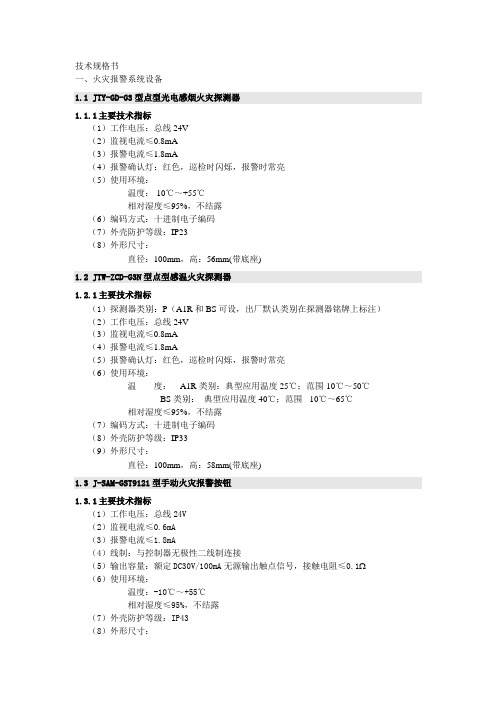
技术规格书一、火灾报警系统设备1.1JTY-GD-G3型点型光电感烟火灾探测器1.1.1主要技术指标(1)工作电压:总线24V(2)监视电流≤0.8mA(3)报警电流≤1.8mA(4)报警确认灯:红色,巡检时闪烁,报警时常亮(5)使用环境:温度:-10℃~+55℃相对湿度≤95%,不结露(6)编码方式:十进制电子编码(7)外壳防护等级:IP23(8)外形尺寸:直径:100mm,高:56mm(带底座)1.2JTW-ZCD-G3N型点型感温火灾探测器1.2.1主要技术指标(1)探测器类别:P(A1R和BS可设,出厂默认类别在探测器铭牌上标注)(2)工作电压:总线24V(3)监视电流≤0.8mA(4)报警电流≤1.8mA(5)报警确认灯:红色,巡检时闪烁,报警时常亮(6)使用环境:温度:A1R类别:典型应用温度25℃;范围-10℃~50℃BS类别:典型应用温度40℃;范围-10℃~65℃相对湿度≤95%,不结露(7)编码方式:十进制电子编码(8)外壳防护等级:IP33(9)外形尺寸:直径:100mm,高:58mm(带底座)1.3J-SAM-GST9121型手动火灾报警按钮1.3.1主要技术指标(1)工作电压:总线24V(2)监视电流≤0.6mA(3)报警电流≤1.8mA(4)线制:与控制器无极性二线制连接(5)输出容量:额定DC30V/100mA无源输出触点信号,接触电阻≤0.1(6)使用环境:温度:-10℃~+55℃相对湿度≤95%,不结露(7)外壳防护等级:IP43(8)外形尺寸:95.4mm×98.4mm×45.5mm (带底壳)1.4J-SAM-GST9123型消火栓按钮1.4.1主要技术指标(1)工作电压:总线24V(2)监视电流≤0.8mA(3)报警电流≤2mA(4)线制:消火栓按钮与火灾报警控制器信号二总线连接,若需实现直接启泵控制,需将消火栓按钮与泵控制箱采用二线连接(5)指示灯启动:红色,巡检时闪亮,消火栓按钮按下时此灯点亮回答:绿色,消防水泵运行时此灯点亮(6)无源输出触点容量:DC30V/100mA(7)使用环境:温度:-10℃~+55℃相对湿度≤95%,不结露(8)外壳防护等级:IP65(9)外形尺寸:95.4mm×98.4mm×52.5mm (带底壳)1.5HX-100B、HX-100B/T型火灾声光警报器1.5.1主要技术指标(1)工作电压:信号总线电压:24V 允许范围:16V~28V电源总线电压:DC24V 允许范围:DC20V~DC28V(2)工作电流:总线监视电流≤0.8mA 总线启动电流≤6.0mA电源监视电流≤10mA 电源动作电流≤90mA(3)线制:四线制,与控制器采用无极性信号二总线连接,与电源线采用无极性二线制连接(4)声压级:80dB~115dB(前方3m水平处(A计权))(5)闪光频率:1.0Hz~1.4Hz(6)变调周期:4s(1±20%)(7)声调:火警声(8)使用环境:温度:-10℃~+50℃相对湿度≤95%,不结露(9)外壳防护等级:IP43(10)执行标准:GB 26851-2011(11)外形尺寸:90mm×144mm×60.5mm(带底壳)1.6GST-LD-8300型输入模块1.6.1主要技术指标(1)工作电压:总线24V(2)工作电流≤1mA(3)线制:与控制器的信号二总线连接(4)出厂设置:常开检线方式(5)使用环境:温度:-10℃~+55℃相对湿度≤95%,不结露(6)外壳防护等级:IP30(7)外形尺寸:86mm×86mm×43mm(带底壳)1.7GST-LD-8301型输入/输出模块1.7.1主要技术指标(1)工作电压:总线电压:总线24V电源电压:DC24V(2)监视电流:总线电流≤1mA电源电流≤5mA(3)动作电流:总线电流≤3mA电源电流≤20mA(4)线制:与控制器采用无极性信号二总线连接,与DC24V电源采用无极性电源二总线连接(5)无源输出触点容量:DC24V/2A,正常时触点阻值为100kΩ,启动时闭合,适用于12V~48V直流或交流(6)输出控制方式:脉冲、电平(继电器常开触点输出或有源输出,脉冲启动时继电器吸合时间为10s)(7)出厂设置:常开检线输入、无源输出方式(8)使用环境:温度:-10℃~+55℃相对湿度≤95%,不结露(9)外壳防护等级:IP30(10)外形尺寸:86mm×86mm×43mm(带底壳)1.8GST-LD-8313型隔离器1.8.1主要技术指标(1)工作电压:总线24V(2)动作电流≤100mA(3)动作确认灯:黄色(4)使用环境:温度:-10℃~+50℃相对湿度≤95%,不结露(5)外壳防护等级:IP30(6)外形尺寸:86mm×86mm×43mm(带底壳)1.9ZF-500型火灾显示盘1.9.1主要技术指标(1)显示方式:可显示报警时间、设备号、设备类型、注释信息(2)显示容量:最多不超过126条汉字报警信息(3)线制:与火灾报警控制器间采用有极性二总线连接,另需两根DC24V电源供电线(不分极性)(4)使用环境:温度:0℃~+40℃相对湿度≤95%,不结露(5)电源:采用DC24V电源集中供电(6)静态功耗≤2W,最大功耗≤5W(7)外形尺寸:206mm×115mm×44mm1.10J B-QB-GST500型火灾报警控制器(联动型)1.10.1主要技术指标(1)液晶屏规格:320×240图形点阵,可显示12行汉字信息(2)控制器容量:a.可带二个242地址编码点回路,最大容量为484个地址编码点b.可外接64台火灾显示盘;联网时最多可接32台其它类型控制器c.64个直接手动操作总线制控制点d.最大可配置10路直接控制点(3)线制:a. 控制器与探测器间采用无极性信号二总线连接,与各类控制模块间除无极性二总线外,还需外加二根DC24V电源总线b. 与其它类型的控制器采用有极性二总线连接,对于火灾报警显示盘,需外加两根DC24V电源供电总线c. 与彩色CRT系统采用四芯扁平电话线,通过RS-232标准接口连接,最大连接线长度不宜超过15md. 直接控制点与现场设备采用三线连接(4)使用环境:温度:0℃~+40℃相对湿度≤95%,不结露(5)电源:主电为交流220V+10%-15%,内装DC24V 14Ah密封铅电池作备电(6)监控状态功耗≤55W,火警状态最大功耗≤70W(7)最大接线长度≤1000m1.主要技术指标(1)额定输出容量:DC24V、6A(2)使用环境:温度:0℃~+40℃相对湿度≤95%,不结露(3)电源:主电为交流220V+10%-15%, DC24V 24Ah密封铅电池作备电(4)外形尺寸:484mm⨯89mm⨯325mm2.1主要技术指标1)工作电压:交流AC220V 50/60Hz ,允许电压变化范围 AC176V~AC264V;2)功耗:监视状态功耗≤20W;最大功耗≤150W;3)备用电源:2个DC12V/7Ah密封铅电池;4)气体喷洒输出:DC24V/3A,脉冲方式/持续方式,可调;5)辅助24V电源输出:最大0.6A;6)电池充电电流:0.6A~0.8A;7)液晶屏规格:128×64点,可同屏显示32个汉字信息;8)容量可带1个区的气体灭火设备,实现对1个防护区的保护。
20种设备技术规格书Z精品文档124页

HX机车检修基地建设配套工装技术要求机务段2013年5月2日目录所有工装设备基本要求 (5)附件1:检修拆装设备 (9)1、小齿轮拆装设备 (10)2、电机轴承压装机 (11)3、电机电枢轴拆装设备 (11)4、HX2车钩缓冲器拆装专用设备 (12)附件2:超声波探伤设备 (14)便携式轮辋轮辐探伤设备 (15)轮对超声波探伤仪 (17)附件3:磁粉探伤设备 (19)轮对荧光磁粉探伤机(含基础) (20)车轴磁粉探伤设备(含基础) (22)附件4:性能试验台等 (24)性能试验台(含基础、电源) (25)耐压试验台 (27)附件5:轮对检修流水线 (29)1、齿轮箱油洗机 (30)2、真空吸油机 (31)3、轴箱轴承自动拆装设备 (31)4、多功能轮对分解压装机 (32)5、制动盘拆卸装置 (33)6、制动盘组装装置 (34)7、车轮静平衡试验机 (35)8、轴颈尺寸测量机 (35)9、轴箱轴承自动组装设备 (36)10、轴端螺栓智能扳机 (37)11、转向架静载设备 (38)附件6:起重设备 (41)5/3.2T双梁桥式起重机 (41)10/3.2T双梁桥式起重机(轮对、牵引电机库) (45)10/3.2T双梁桥式起重机(辅机库) (48)附件7:自立式起重机 (51)自立式起重机 (52)附件8:转盘 (54)附件9:运输用小车等 (57)平板车 (58)搬运车 (60)运输小车 (62)附件10:清洗、喷漆、烘干设备 (63)辅机吹扫设备 (64)辅机清洗设备 (66)辅机烘干设备 (68)转向架喷漆烘干设备 (70)冲洗机 (72)齿轮箱超声波清洗机 (73)附件11:压力机等 (75)压力机 (76)HX2辅机轴承压装机 (78)风叶压装机 (80)附件12:牵引电机喷漆、清洗、烘干设备 (82)1、喷漆设备 (83)2、吹扫设备 (84)3、清洗设备 (85)4、烘干设备 (86)5、浸漆设备 (87)6、部件清洗设备 (88)附件13:辅机及动平衡试验设备 (90)HX辅机转子动平衡试验台 (91)转子动平衡试验台 (93)HX2辅机试验台 (95)附件14:空压机及冷干机等工装设备 (97)空压机及冷干机 (98)风管水压试验台 (103)铜焊机 (105)附件15:公铁两用牵引车 (107)附件16:车钩缓冲器综合试验台 (110)附件17:轮对镟修床(车轮车床) (113)附件18:车轴磨床 (117)附件19:单元制动器试验台 (120)附件20:管道综合支架 (122)所有工装设备基本要求1、设备的设计、制造与试验应符合国际工业标准(ISO)和国际电工标准(IEC),度量单位全部采用国际单位标准制( SI)。
(完整版)技术规格书汇总,推荐文档

86mm×86mm×43mm(带底壳)
1.7 GST-LD-8301 型输入/输出模块
1.7.1 主要技术指标 (1)工作电压: 总线电压:总线24V 电源电压:DC24V (2)监视电流: 总线电流≤1mA 电源电流≤5mA (3)动作电流: 总线电流≤3mA 电源电流≤20mA (4)线制:与控制器采用无极性信号二总线连接,与 DC24V 电源采用无极性电源二
(1) 线制
线制
连接线
距离
负载或连接设备
通信总线 24V
≥1.0 mm2 双绞线 <0.5km 总线设备
电源线 DC24V CAN 总线
1.0~2.0mm2RV 线 ≥1.0mm2 双绞线
<0.5km <3.0km
小于 0.6A 区域或集中控制器
或屏蔽线
其它线
1.0~2.0mm2RV 线 <0.5km
482.6mm×88.1mm×155.0mm(GST-TS-Z01A) 482.6mm×88.1mm×100.0mm(GST-TS-Z01B)
3. GST-TS-100A/100B 型消防电话分机
3.1 主要技术指标
(1)工作电压:DC24V,允许范围:DC20V~DC28V (2)工作电流:通话时电流约为 65mA (3)线制:无极性二总线制 (4)使用环境:
总线连接 (5)无源输出触点容量:DC24V/2A,正常时触点阻值为 100kΩ,启动时闭合,适用
于 12V~48V 直流或交流 (6)输出控制方式:脉冲、电平(继电器常开触点输出或有源输出,脉冲启动时继电
器吸合时间为 10s) (7)出厂设置:常开检线输入、无源输出方式 (8)使用环境: 温度:-10℃~+55℃ 相对湿度≤95%,不结露 (9)外壳防护等级:IP30 (10)外形尺寸: 86mm×86mm×43mm(带底壳)
(完整word版)技术规格书.doc

技术规格书★一、技术参数详见附件1货物清单。
★二、技术标准设备标准:合同设备如在中国有强制性国家标准或行业标准的,适用该标准,如在中国无强制性国家标准或行业标准的,适用国家推荐性标准、地方标准或按法规规章要求备案的企业标准;同时须满足合同约定的标准,以及产品合格证书的技术性能参数、质量参数。
强制性国家标准或行业标准必须是有关机构发布的最新版本的标准。
★三、验收要求中标人交付的货物必须达到以上提及的质量标准以及合格证书、技术性能参数、质量参数和国家质量标准。
检验方法如下,由甲方选取一种或多种方式检验:(1) 采取目测和简易测量的方法对货物的外观检验,对照合格证书对产品进行检验。
(2) 采取送验的方法对货物进行检验,如检验不合格,检验费由中标人支付。
(3) 采取试用的方法对货物进行检验。
★四、货物要求(一)合同签订以后,甲方将向乙方发出采购订单,乙方在收到采购订单后必须在不多于30天内完成所有设备的配送、安装、调试等相关工作。
(二)乙方在设备的配送前必须与甲方收货、验货有关人员进行充分沟通,根据甲方有关人员确定的收货时间、地点和其他送货要求进行设备的配送、安装,在配送和安装的过程不能够对甲方的生产、安全和卫生方面造成影响。
(三)乙方须提交厂家签署的质量证明书正本一份。
(四)乙方交付的设备须达到甲方对本合同设备制定的检验标准:按照采购清单设备描述及技术规格书的相关要求验收。
(五)检验方法:本清单设备由甲方根据实际情况选择以下一种或几种检验方法检验;1.采取目测和简易测量的方法对货物的外观进行检验;检查相关证书、证件的齐备性;对照适用标准、本合同约定的标准以及合格证书或产品质量保证书对产品进行检验。
2.采取送验的方法对设备进行检验。
3.采取试用的方法对设备进行检验。
4.对照样板进行检验。
★五、交货时间接到我司订单后须在不多于30天内送达业主指定的交货地点,并完成货物的安装、调试工作。
如中标人承诺的货期比招标人要求时间短,以中标人承诺的货期为准。
物资技术规格书
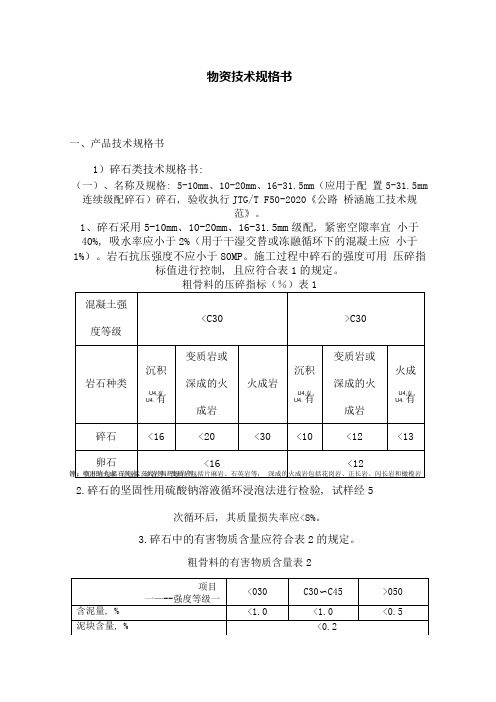
物资技术规格书一、产品技术规格书1)碎石类技术规格书:(一)、名称及规格: 5-10mm、10-20mm、16-31.5mm(应用于配置5-31.5mm 连续级配碎石)碎石, 验收执行JTG/T F50-2020《公路桥涵施工技术规范》。
1、碎石采用5-10mm、10-20mm、16-31.5mm级配, 紧密空隙率宜小于40%, 吸水率应小于2%(用于干湿交替或冻融循环下的混凝土应小于1%)。
岩石抗压强度不应小于80MP。
施工过程中碎石的强度可用压碎指标值进行控制, 且应符合表1的规定。
粗骨料的压碎指标(%)表12.碎石的坚固性用硫酸钠溶液循环浸泡法进行检验, 试样经5次循环后, 其质量损失率应<8%。
3.碎石中的有害物质含量应符合表2的规定。
粗骨料的有害物质含量表2碎石的碱活性应首先采用岩相法检验。
若碎石含有碱一硅酸反应活性矿物, 其砂浆棒膨胀率应小于0.10%, 否则应采取抑制碱一骨料反应的技术措施。
不得使用具有碱一碳酸盐反应活性的骨料。
干湿交替或冻融破坏环境下, 粗骨料的吸水率应小于1%。
4、片石需质地坚硬, 不易风化, 无裂缝, 片石表面不得有水锈,强度不小于MU40,片石表面的污渍必须予以清除;片石形状不受限制, 但其中部厚度不低于15cm, 用作镶面的片石表面得平整、尺寸较大, 边缘厚度不得小于15cm。
2)河砂、机制砂(中砂)②注: ①砂按照产源地分为天然砂、机制砂两类;按照技术要求分为I类、II类、III类。
③石粉含量系数至机制砂中粒径小于75^m的颗粒含量。
④当工程有要求时, 含水率和饱和面干吸水率应采用实测值。
⑤砂中不应混有草根、树叶、树枝、煤块、炉渣等杂物。
2.2检查及验收:按JTG/T F50-2020《公路桥涵施工技术规范》的规定验收, 按在交货地点的过磅(检斤)计重交货。
过磅后须检测含水率, 实际收货数量为过磅后重量扣除水分重量, 含水率3%以内不扣, 超过3%扣除超出部分。
技术规格书
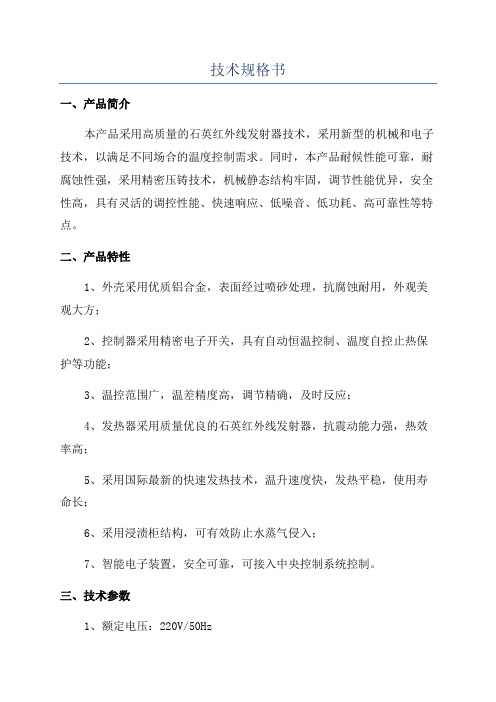
技术规格书
一、产品简介
本产品采用高质量的石英红外线发射器技术,采用新型的机械和电子技术,以满足不同场合的温度控制需求。
同时,本产品耐候性能可靠,耐腐蚀性强,采用精密压铸技术,机械静态结构牢固,调节性能优异,安全性高,具有灵活的调控性能、快速响应、低噪音、低功耗、高可靠性等特点。
二、产品特性
1、外壳采用优质铝合金,表面经过喷砂处理,抗腐蚀耐用,外观美观大方;
2、控制器采用精密电子开关,具有自动恒温控制、温度自控止热保护等功能;
3、温控范围广,温差精度高,调节精确,及时反应;
4、发热器采用质量优良的石英红外线发射器,抗震动能力强,热效率高;
5、采用国际最新的快速发热技术,温升速度快,发热平稳,使用寿命长;
6、采用浸渍柜结构,可有效防止水蒸气侵入;
7、智能电子装置,安全可靠,可接入中央控制系统控制。
三、技术参数
1、额定电压:220V/50Hz
2、功率:500W
3、温控范围:0-60℃
4、热响应速度:≤20s
5、容积:18*30cm
6、外壳尺寸:200*150*90mm
7、重量:2.5kg
8、环境温度:-20℃~60℃
9、工作噪音:<55dB
四、安装配置。
- 1、下载文档前请自行甄别文档内容的完整性,平台不提供额外的编辑、内容补充、找答案等附加服务。
- 2、"仅部分预览"的文档,不可在线预览部分如存在完整性等问题,可反馈申请退款(可完整预览的文档不适用该条件!)。
- 3、如文档侵犯您的权益,请联系客服反馈,我们会尽快为您处理(人工客服工作时间:9:00-18:30)。
技术规格书一、火灾报警系统设备1.1JTY-GD-G3型点型光电感烟火灾探测器1.1.1主要技术指标(1)工作电压:总线24V(2)监视电流≤0.8mA(3)报警电流≤1.8mA(4)报警确认灯:红色,巡检时闪烁,报警时常亮(5)使用环境:温度:-10℃~+55℃相对湿度≤95%,不结露(6)编码方式:十进制电子编码(7)外壳防护等级:IP23(8)外形尺寸:直径:100mm,高:56mm(带底座)1.2JTW-ZCD-G3N型点型感温火灾探测器1.2.1主要技术指标(1)探测器类别:P(A1R和BS可设,出厂默认类别在探测器铭牌上标注)(2)工作电压:总线24V(3)监视电流≤0.8mA(4)报警电流≤1.8mA(5)报警确认灯:红色,巡检时闪烁,报警时常亮(6)使用环境:温度:A1R类别:典型应用温度25℃;范围-10℃~50℃BS类别:典型应用温度40℃;范围-10℃~65℃相对湿度≤95%,不结露(7)编码方式:十进制电子编码(8)外壳防护等级:IP33(9)外形尺寸:直径:100mm,高:58mm(带底座)1.3J-SAM-GST9121型手动火灾报警按钮1.3.1主要技术指标(1)工作电压:总线24V(2)监视电流≤0.6mA(3)报警电流≤1.8mA(4)线制:与控制器无极性二线制连接(5)输出容量:额定DC30V/100mA无源输出触点信号,接触电阻≤0.1(6)使用环境:温度:-10℃~+55℃相对湿度≤95%,不结露(7)外壳防护等级:IP43(8)外形尺寸:95.4mm×98.4mm×45.5mm (带底壳)1.4J-SAM-GST9123型消火栓按钮1.4.1主要技术指标(1)工作电压:总线24V(2)监视电流≤0.8mA(3)报警电流≤2mA(4)线制:消火栓按钮与火灾报警控制器信号二总线连接,若需实现直接启泵控制,需将消火栓按钮与泵控制箱采用二线连接(5)指示灯启动:红色,巡检时闪亮,消火栓按钮按下时此灯点亮回答:绿色,消防水泵运行时此灯点亮(6)无源输出触点容量:DC30V/100mA(7)使用环境:温度:-10℃~+55℃相对湿度≤95%,不结露(8)外壳防护等级:IP65(9)外形尺寸:95.4mm×98.4mm×52.5mm (带底壳)1.5HX-100B、HX-100B/T型火灾声光警报器1.5.1主要技术指标(1)工作电压:信号总线电压:24V 允许范围:16V~28V电源总线电压:DC24V 允许范围:DC20V~DC28V(2)工作电流:总线监视电流≤0.8mA 总线启动电流≤6.0mA电源监视电流≤10mA 电源动作电流≤90mA(3)线制:四线制,与控制器采用无极性信号二总线连接,与电源线采用无极性二线制连接(4)声压级:80dB~115dB(前方3m水平处(A计权))(5)闪光频率:1.0Hz~1.4Hz(6)变调周期:4s(1±20%)(7)声调:火警声(8)使用环境:温度:-10℃~+50℃相对湿度≤95%,不结露(9)外壳防护等级:IP43(10)执行标准:GB 26851-2011(11)外形尺寸:90mm×144mm×60.5mm(带底壳)1.6GST-LD-8300型输入模块1.6.1主要技术指标(1)工作电压:总线24V(2)工作电流≤1mA(3)线制:与控制器的信号二总线连接(4)出厂设置:常开检线方式(5)使用环境:温度:-10℃~+55℃相对湿度≤95%,不结露(6)外壳防护等级:IP30(7)外形尺寸:86mm×86mm×43mm(带底壳)1.7GST-LD-8301型输入/输出模块1.7.1主要技术指标(1)工作电压:总线电压:总线24V电源电压:DC24V(2)监视电流:总线电流≤1mA电源电流≤5mA(3)动作电流:总线电流≤3mA电源电流≤20mA(4)线制:与控制器采用无极性信号二总线连接,与DC24V电源采用无极性电源二总线连接(5)无源输出触点容量:DC24V/2A,正常时触点阻值为100kΩ,启动时闭合,适用于12V~48V直流或交流(6)输出控制方式:脉冲、电平(继电器常开触点输出或有源输出,脉冲启动时继电器吸合时间为10s)(7)出厂设置:常开检线输入、无源输出方式(8)使用环境:温度:-10℃~+55℃相对湿度≤95%,不结露(9)外壳防护等级:IP30(10)外形尺寸:86mm×86mm×43mm(带底壳)1.8GST-LD-8313型隔离器1.8.1主要技术指标(1)工作电压:总线24V(2)动作电流≤100mA(3)动作确认灯:黄色(4)使用环境:温度:-10℃~+50℃相对湿度≤95%,不结露(5)外壳防护等级:IP30(6)外形尺寸:86mm×86mm×43mm(带底壳)1.9ZF-500型火灾显示盘1.9.1主要技术指标(1)显示方式:可显示报警时间、设备号、设备类型、注释信息(2)显示容量:最多不超过126条汉字报警信息(3)线制:与火灾报警控制器间采用有极性二总线连接,另需两根DC24V电源供电线(不分极性)(4)使用环境:温度:0℃~+40℃相对湿度≤95%,不结露(5)电源:采用DC24V电源集中供电(6)静态功耗≤2W,最大功耗≤5W(7)外形尺寸:206mm×115mm×44mm1.10J B-QB-GST500型火灾报警控制器(联动型)1.10.1主要技术指标(1)液晶屏规格:320×240图形点阵,可显示12行汉字信息(2)控制器容量:a.可带二个242地址编码点回路,最大容量为484个地址编码点b.可外接64台火灾显示盘;联网时最多可接32台其它类型控制器c.64个直接手动操作总线制控制点d.最大可配置10路直接控制点(3)线制:a. 控制器与探测器间采用无极性信号二总线连接,与各类控制模块间除无极性二总线外,还需外加二根DC24V电源总线b. 与其它类型的控制器采用有极性二总线连接,对于火灾报警显示盘,需外加两根DC24V电源供电总线c. 与彩色CRT系统采用四芯扁平电话线,通过RS-232标准接口连接,最大连接线长度不宜超过15md. 直接控制点与现场设备采用三线连接(4)使用环境:温度:0℃~+40℃相对湿度≤95%,不结露(5)电源:主电为交流220V+10%-15%,内装DC24V 14Ah密封铅电池作备电(6)监控状态功耗≤55W,火警状态最大功耗≤70W(7)最大接线长度≤1000m1.主要技术指标(1)额定输出容量:DC24V、6A(2)使用环境:温度:0℃~+40℃相对湿度≤95%,不结露(3)电源:主电为交流220V+10%-15%, DC24V 24Ah密封铅电池作备电(4)外形尺寸:484mm⨯89mm⨯325mm2.1主要技术指标1)工作电压:交流AC220V 50/60Hz ,允许电压变化范围 AC176V~AC264V;2)功耗:监视状态功耗≤20W;最大功耗≤150W;3)备用电源:2个DC12V/7Ah密封铅电池;4)气体喷洒输出:DC24V/3A,脉冲方式/持续方式,可调;5)辅助24V电源输出:最大0.6A;6)电池充电电流:0.6A~0.8A;7)液晶屏规格:128×64点,可同屏显示32个汉字信息;8)容量可带1个区的气体灭火设备,实现对1个防护区的保护。
其中所带设备及数量如下: 电磁阀:1个,额定电压DC24V,最大电流3A;压力开关:1个,常开触点,动作时闭合;区域讯响器:1~5个,编码地址范围1~90;气体释放警报器:1~5个,编码地址范围1~90;紧急启/停按钮和手自动转换开关:共1~10个,编码地址范围1~90;输出模块:1~3个,编码地址范围1~90;点型感烟探测器:1~20个,编码地址范围1~90;其它探测器(如感温、火焰等):1~20个,编码地址范围1~90;手动报警按钮:1~10个,编码地址范围1~90;声光警报器:1~2个,非编码。
(1)线制(2)使用环境工作温度:-10℃~50℃相对湿度≤95%,不凝露(3)外形尺寸:长413mm×宽330mm×厚97mm。
(4)壁挂安装于防护区门口,支持上进线方式。
2.2主要技术指标(1)工作电压:信号总线电压:24V 允许范围:16V~28V电源总线电压:DC24V 允许范围:DC20V~DC28V(2)工作电流:信号总线监视电流≤1mA 电源总线监视电流≤2mA信号总线动作电流≤2mA 电源总线动作电流≤30mA(3)闪光频率:1.3Hz±20%(4)编码方式:电子编码方式,编码范围可在11~20之间任意设定(5)线制:与气体灭火控制器采用四线连接。
其中两线接总线,无极性;另外两线接电源DC24V,无极性(6)使用环境:温度:-10℃~+50℃相对湿度≤95%,不凝露(7)外形尺寸:348mm×159mm×25mm(带底壳)2.3主要技术指标(1)工作电压:总线24V,允许范围:16V~28V(2)监视电流:≤0.8mA,报警电流≤10mA(3)编码方式:电子编码方式,编码范围可在21~30之间任意设定(4)常开输出触点:额定值DC60V、0.1A,接触电阻≤100mΩ(5)启动方式:击碎玻璃罩后,按下“按下喷洒”按键(6)启动零件类型:重复使用型(7)“按下喷洒”按键复位方式:用专用钥匙复位(8)指示灯:“按下喷洒”按键:红色,按下时常亮“停止”按键:绿色,按下时常亮(9)线制:与气体灭火控制器采用无极性两线制连接(10)外壳防护等级:IP33(11)使用环境:温度:-10℃~+55℃相对湿度≤95%,不凝露(12)外形尺寸:112(长)mm⨯133(高)mm⨯65mm(厚)1.主要技术指标(1)工作电压:DC24V±10%(2)工作电流≤0.5A(3)允许消防电话分机环路电阻:<1000欧姆(4)频率范围:300~3400Hz(5)串音电平:<-60dB(6)传输损耗:<5dB(7)使用环境:温度:0℃~+40℃相对湿度≤95%,不结露(8)外形尺寸:482.6mm×88.1mm×155.0mm(GST-TS-Z01A)482.6mm×88.1mm×100.0mm(GST-TS-Z01B)3.1主要技术指标(1)工作电压:DC24V,允许范围:DC20V~DC28V(2)工作电流:通话时电流约为65mA(3)线制:无极性二总线制(4)使用环境:温度:-10℃~+50℃相对湿度≤95%,不结露(5)外壳防护等级:IP30(6)外形尺寸:GST-TS-100A为:206mm×56mm×51.5mm(含底座)GST-TS-100B为:200mm×50mm×38.3mm二、空气采样设备及ups四管数码显示型,单台保护面积为2000㎡。
